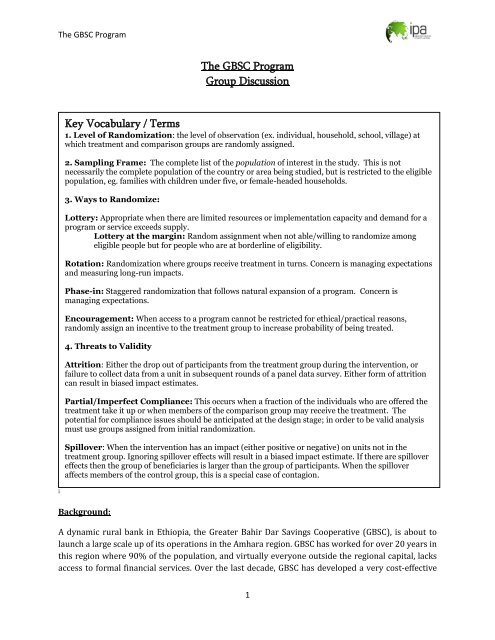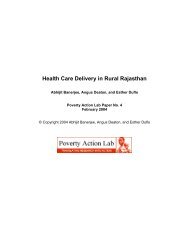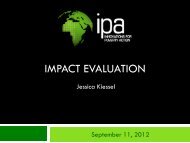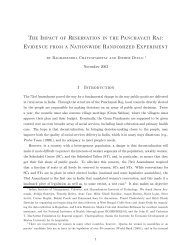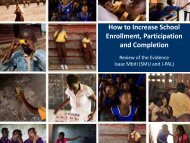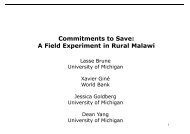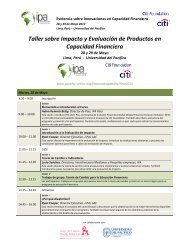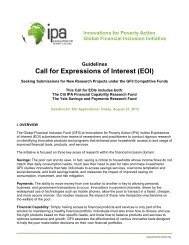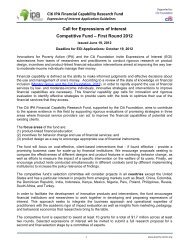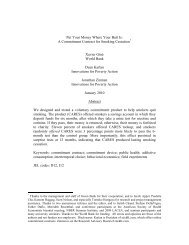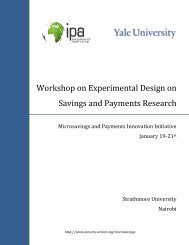The GBSC Program Group Discussion Key Vocabulary / Terms
The GBSC Program Group Discussion Key Vocabulary / Terms
The GBSC Program Group Discussion Key Vocabulary / Terms
Create successful ePaper yourself
Turn your PDF publications into a flip-book with our unique Google optimized e-Paper software.
<strong>The</strong> <strong>GBSC</strong> <strong>Program</strong><br />
<strong>The</strong> <strong>GBSC</strong> <strong>Program</strong><br />
<strong>Group</strong> <strong>Discussion</strong><br />
<strong>Key</strong> <strong>Vocabulary</strong> / <strong>Terms</strong><br />
1. Level of Randomization: the level of observation (ex. individual, household, school, village) at<br />
which treatment and comparison groups are randomly assigned.<br />
2. Sampling Frame: <strong>The</strong> complete list of the population of interest in the study. This is not<br />
necessarily the complete population of the country or area being studied, but is restricted to the eligible<br />
population, eg. families with children under five, or female-headed households.<br />
3. Ways to Randomize:<br />
Lottery: Appropriate when there are limited resources or implementation capacity and demand for a<br />
program or service exceeds supply.<br />
Lottery at the margin: Random assignment when not able/willing to randomize among<br />
eligible people but for people who are at borderline of eligibility.<br />
Rotation: Randomization where groups receive treatment in turns. Concern is managing expectations<br />
and measuring long-run impacts.<br />
Phase-in: Staggered randomization that follows natural expansion of a program. Concern is<br />
managing expectations.<br />
Encouragement: When access to a program cannot be restricted for ethical/practical reasons,<br />
randomly assign an incentive to the treatment group to increase probability of being treated.<br />
4. Threats to Validity<br />
Attrition: Either the drop out of participants from the treatment group during the intervention, or<br />
failure to collect data from a unit in subsequent rounds of a panel data survey. Either form of attrition<br />
can result in biased impact estimates.<br />
Partial/Imperfect Compliance: This occurs when a fraction of the individuals who are offered the<br />
treatment take it up or when members of the comparison group may receive the treatment. <strong>The</strong><br />
potential for compliance issues should be anticipated at the design stage; in order to be valid analysis<br />
must use groups assigned from initial randomization.<br />
Spillover: When the intervention has an impact (either positive or negative) on units not in the<br />
treatment group. Ignoring spillover effects will result in a biased impact estimate. If there are spillover<br />
effects then the group of beneficiaries is larger than the group of participants. When the spillover<br />
affects members of the control group, this is a special case of contagion.<br />
i<br />
Background:<br />
A dynamic rural bank in Ethiopia, the Greater Bahir Dar Savings Cooperative (<strong>GBSC</strong>), is about to<br />
launch a large scale up of its operations in the Amhara region. <strong>GBSC</strong> has worked for over 20 years in<br />
this region where 90% of the population, and virtually everyone outside the regional capital, lacks<br />
access to formal financial services. Over the last decade, <strong>GBSC</strong> has developed a very cost-effective<br />
1
<strong>The</strong> <strong>GBSC</strong> <strong>Program</strong><br />
protocol for delivery of financial services in rural areas using point of sale technology. <strong>The</strong> model<br />
works as follows: <strong>GBSC</strong> vets and enrolls individuals who live in rural areas to become agents of the<br />
cooperative. <strong>The</strong>se individuals then enroll and carry out transactions for <strong>GBSC</strong> clients using a<br />
biometric point of sale technology. Accounts can be used to send money or pay bills, but <strong>GBSC</strong> also<br />
hopes that clients can maintain a positive balance on their accounts and thus accumulate savings.<br />
Agents often operate out of a central, existing place of work, such as a general store, though<br />
sometimes they travel to client homes in surrounding villages. <strong>GBSC</strong> coordinators visit the agents<br />
on a weekly basis to pick up and deliver cash, though they can come immediately if there is an<br />
urgent liquidity issue. Starting in 2011, after a promising pilot, the management began an ambitious<br />
marketing campaign, planning to open 15,000 new savings accounts in four provinces by the end of<br />
the year.<br />
While <strong>GBSC</strong>’s new product appears to have no technological glitches, and in initial focus group<br />
discussions customers have been keen to open an account, take-up of the product levels remain<br />
very low. Instead of the targeted 15,000 accounts, <strong>GBSC</strong> only managed to open 3,700 accounts.<br />
Among those who have opened an account, many do not seem to use it for savings, continuing<br />
instead to save by storing money under their mattress or through the purchase of jewelry or<br />
livestock. At the end of December, <strong>GBSC</strong> conducted a short representative survey of about 3,000<br />
adults living in the villages where their 200 <strong>GBSC</strong> agents operate and held a series of focus groups<br />
examining attitudes towards saving and consumption. Some of these villages have a population of<br />
80, while others are as large as thirty thousand. <strong>The</strong> survey showed that about 800 of the surveyed<br />
individuals only a small percentage have an <strong>GBSC</strong> account. Responses from the focus groups<br />
revealed low levels of information about the benefits of savings, ignorance of details regarding how<br />
the account worked, and a preference for the tangible / visible reminders of their savings that<br />
livestock and jewelry provided.<br />
<strong>GBSC</strong> has reached out to IPA researchers to conduct a study testing the impacts of alternative<br />
strategies to spur uptake among their new clients. <strong>The</strong>y decided to provide information to<br />
establish trust among clients, explain the benefits of the account, and explain how the account<br />
works. <strong>The</strong>y have considered the following range of interventions:<br />
- workshops and community meetings<br />
- individual visits to potential clients<br />
- advertisements (using posters in community centers, radio or television, leaflets)<br />
- text message based promotions<br />
- promotions such as a raffle among those who enroll<br />
<strong>GBSC</strong> would like to know whether providing information increases the likelihood that potential<br />
clients will sign up for accounts. <strong>The</strong>y would also like to know whether accountholders who<br />
received information end up saving more.<br />
2
<strong>The</strong> <strong>GBSC</strong> <strong>Program</strong><br />
<strong>Group</strong> <strong>Discussion</strong><br />
How would you evaluate the effectiveness of the proposed marketing campaign Choose a couple of<br />
the alternatives that <strong>GBSC</strong> proposes design a study that keeps logistical, financial, and political<br />
constraints under consideration.<br />
1) First, specify the level of randomization: Of the interventions that <strong>GBSC</strong> is considering,<br />
which are more appropriate to individual level randomization Which would require group<br />
level randomization Discuss the advantages and disadvantages of each, including potential<br />
threats to validity.<br />
2) How would you suggest that <strong>GBSC</strong> actually conduct the intervention(s) in order to make a<br />
randomized trial possible<br />
3) In studies that look at takeup as an important outcome variable, you need to have a sample<br />
frame. Examples include: list of farmers belonging to a particular association to see what<br />
percent uses fertilizer; census of adults in a village to see who takes up a micro-loan;<br />
recipients of marketing letters or emails with different messages. What is your sample<br />
frame in this study How will you select the control group<br />
4) What if <strong>GBSC</strong> were to try more than one intervention <strong>The</strong>y are curious to know if one<br />
marketing method is more cost-effective than another, and if there is a multiplier effect<br />
when two interventions are combined. How would you design the study to answer these<br />
questions<br />
i Some definitions paraphrased from 3ie (2009) 3ie impact evaluation glossary. International Initiative for Impact<br />
Evaluation: New Delhi, India<br />
3


